How Much Money Can You Save By Gardening In An Apartment

3 Expert Gardeners Offer Tips on Apartment Gardening for Beginners
Apartment gardening for beginners — and even seasoned gardeners — requires a different approach. With the help of three expert gardeners, we've created a how-to guide for renters.
Whether you're looking to get in touch with nature or if you want to supplement your own pizza/burger food supply, there are various reasons why you choose to garden.
To create your own garden space, it all starts with goal setting and planning first. From budget to space considerations, the more time you put into upfront planning, the better your apartment garden will be.
What to Grow in Your Apartment Garden?
Let's think functionally. Do you like to cook, and do you plan on your garden producing food for your own meals? If that's the case, you'll want to choose herbs or plants that produce a number of ingredients. This includes fresh greens for salads, or commonly used herbs like basil.
Consider your goals for the space. Do you want a hipster balcony with ornamental plants that blend in with your décor? Or are you going strictly utilitarian, in which herbs and vegetables will help offset your grocery budget?
The cost of plants or seeds will also weigh heavily in your choice. Larger flowering plants aren't cheap, so it's probably best to start out with a budget before you go shopping, allowing you to allocate resources accordingly.
If you're going the vegetable route, Luke Marion offers some expert advice.
Apartment Vegetable Gardening from Luke Marion, MI Gardener

Photo Courtesy of Luke Marion, MI Gardener
Keep things small, compact, and intentional. Many apartment gardeners want to grow a garden like most large-scale gardens they see. This ends up being wasteful on space, and does not have the same money saving impact it could have.
Stick with containers less than 5 gallons each to save space, and focus on growing herbs and salad greens which are expensive and never fresh, and high yielding crops like tomatoes, peppers, eggplant, and green beans. All of these options grow compact, are fresher, tastier, and save loads of money when compared to buying them from the store.
Growing things you eat also is important because having something you don't eat a lot of will lead you to have wasted space. This is space that could be dedicated to something you will eat more of, saving you more money.
Where to Grow It?
First consider how much sunlight your space will get, as that determines what you'll grow and where you'll be able to grow it.
This great article from urbanorganicgardener.com is worth a read, and breaks down the levels of sunlight into the following categories:
- Full sun: Over 6 hours of direct sunlight
- Partial sun: 4-5 hours of direct sunlight
- Partial shade: 2-4 hours of direct sunlight
- Shade: Less than 1 hour of direct sunlight
Take a look at your spaces, and then make an hourly sketch or capture a photo of the area throughout the day. Evaluate how much sun is truly available and then look for plants that match your location.
For example, a shade plant put in full sun will quickly burn up and wither, and a full sun plant put in part shade will grow leggy and pale looking for more sunlight.
Here are some ideal spaces to grow:
Balcony: Accenting your balcony with the right plants and vegetables can add beautiful color to your balcony or patio. Pinterest is loaded with ideas on how to decorate your balcony, which we highlighted in a recent blog post on Smarter Renter – 11 Spring Decorations for the Apartment.
Fire Escapes: You may want to check with the landlord on this, but a fire escape can be used provided you leave ample clearance for foot traffic.
Walls: Transform ho-hum outdoor wallspace with a vertical garden or even a ladder ornamented with planters.
Handrails: Hanging plants work perfectly with handrails, adding nice accents to an otherwise functional part of your apartment.
Windows: A huge collaborative movement has emerged among urban apartment dwellers looking to improve their ability to grown plants and gardens. It's called R&D-I-Y, which is a worldwide community of indoor gardeners who have collaborated on what it takes to grow "window farms" in urban apartments using hydroponics. It's a fascinating video.
Rooftops and Parking Lots: Depending on your situation, your landlord may allow you to have a small container garden on the rooftop, or in the parking lot of your building. It's worth asking!
Residents at one of our communities in Oregon asked if we'd be willing to allow a community garden on the grounds of our property. It was a great idea and we quickly tilled up a plot and gave the coordinator a gift basket of gardening goodies.
Be conscious of your space consideration, too. Gardens take space, and you don't want them to infringe on your living space. Maintain a nice balance, and make the most of vertical planters. Going up is better than out.
So what if your apartment only offers shady spots? Marie Viljoen, edible gardening / wild foods experts and author of Forage, Harvest Feast – A Wild Inspired Cuisine, has the answer.
Edibles for Shade from Marie Viljoen, 66 Squarefeet

Photo Courtesy of Marie Viljoen, 66 Squarefeet
While many well known vegetables and herbs need full sun to thrive, it is possible to grow interesting edibles in shade, as long as there is not root competition from an established tree.
Spring and fall: arugula, upland cress, and lettuces in general will produce healthy leaves for your salads in high shade or dappled sunlight. Plant before your last frost date and through late spring. Sow again in fall. Fiddleheads are the furled crosiers of ferns: Ostrich fern fiddleheads are seasonal delicacies at farmers markets. The plants thrive in moist shade, making more ferns every year.
Harvest one third of each plant's fiddleheads in mid spring. Ramps grow in shade (and are over-harvested in the wild) – plant them in humus-rich soil from market-bought bunches with roots (they will fade soon but reappear the following season), or buy bulbs online – harvest their leaves, which are packed with flavor.
Summer: Train Malabar spinach on a bamboo teepee – it adds height to the garden and succulence to summer dishes. Grow ginger as an annual crop and harvest the fresh rhizomes in late summer and autumn.
Turmeric and cardamom also thrive in shade: use their aromatic leaves to perfume stews and braises. If planted in pots they can be overwintered indoors. Fragrant Thai and purple basils, as well as parsley grow well in semi to full shade. Nasturtiums will produce (but not many flowers), which are good peppery additions to salads.
What to Grow Your Plants or Flowers In?
If you're on a tight budget and don't have the cash to invest in more expensive clay pots, plastic pots are a great call. While they're not all that pleasing to the eye, they hold their moisture longer than clay.
If you choose clay, know that they don't hold moisture as well, but they allow roots to breathe. A saucer for underneath a clay pot will protect your deck and help retain moisture.
No matter what you choose, the container must align with the look and feel of your apartment. If you like a modern look, brightly colored flowerpots with smiley faces painted on them won't work.
When in doubt, look to Pinterest for new and inspiring ideas! Here are some examples.
Old Shoe Organizers
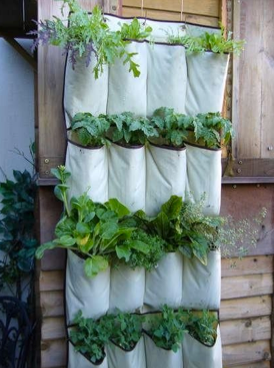
Photo: Smarter You
Gutters
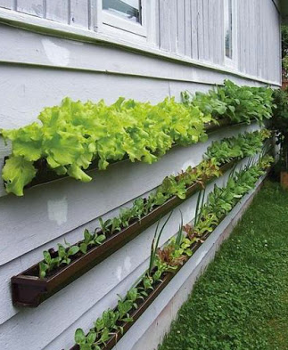
Photo: Juneau Empire
Wine boxes
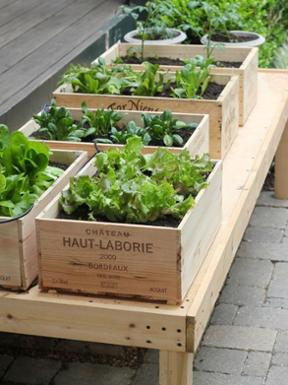
Photo: Home and Garden
Ladders
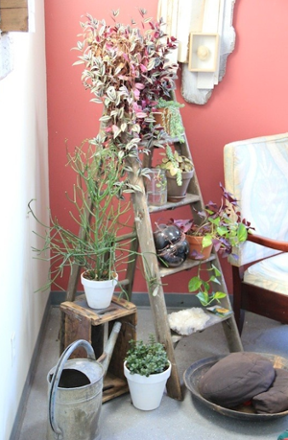
Photo: Home Interiors
For more inspiration, check out this post. It includes the bathtub below converted into a planter/coffee table!
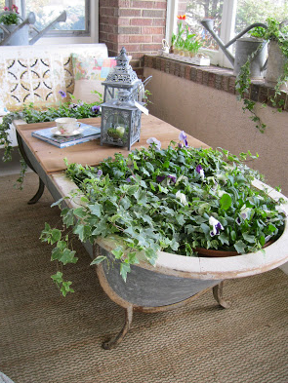
Photo: the Garage Sale Gal
There is no shortage of container options, but what do you plant in those containers?
Apartment Container Gardening from Kathy Diemer, A Garden for All

Photo Courtesy of Kathy Diemer, A Garden for All
With the introduction of innovative and durable containers comes the opportunity to incorporate plants of all shapes and sizes to our outdoor living spaces. Anything from small trees and shrubs, to plants, herbs and edibles can be grown in a container, if provided the proper growing conditions.
Any plant that will thrive in your zone will do well in a properly sized container, while providing beauty to your patio through all four seasons:
- Textural evergreens or trees with colorful bark will give your outdoor space a year-round glow, and flowering perennials and bulbs will offer delight through the spring and summer.
- Herbs love container living, and are naturally attractive plants that can be used both medicinally and for seasoning foods.
- Many edibles, such as tomatoes, cucumbers, eggplant, broccoli (etc.) produce fabulous crops in containers, and look enticing with their vibrant fruits on display.
Container gardening is limited only to your site and ability to care for your plantings. Remember that your plants depend on you for water and nurturing, and to ensure their ongoing health you may need to look into a maintenance service or irrigation system if unable to provide the necessary care.
Most importantly, have fun choosing and designing plants specifically for your glorious outdoor oasis.
What Type of Gardening Tools do You Need?
Before you buy a seed or pot a plant, you need the right tools to get the job done. Here are the core essentials for any apartment gardener – most of which you'll find for sale at gardening supply stores or online.
Garden Fork – Hand Cultivator – Ideal for loosening and aerating the soil.

Source: Plantnatural.com
Gloves – A pair of washable, synthetic gloves should be fine for the urban gardener. Good for deadheading, weeding and handling seeds. If you're going to be doing bigger jobs, like picking up leaves or dealing with thorny plants, get latex-coated cotton gloves.

Source: WomansWork.com
Hand Trowel – A hand trowel is useful for planting seeds, bulbs, etc. Opt for one with a rubber handle.

Source: spaketools.com
Hand Pruner/ Pruning Shears or Scissors – Used for trimming, edging and cutting back plants. Scissors work well for cutting twine and removing dead flowers, while hand pruners are best for small, woody plants or branches.

Source: Gardendirect.com
Hand Rake – Useful for removing debris around plants or picking up small piles of leaves.

Source: Toolstop.co.uk
Watering Can – Watering cans come in a variety of shapes and sizes. Opt for one with measure marks.

Source: planetnatural.com
Gardening Seat or kneeler/kneepads – You probably won't be using many long-handled tools, so kneeling and crouching will be the norm. These seats and kneelers go easy on the knees or bottom so you can garden in comfort.

Source: urbangardensweb.com
Tub Trug – Good for keeping tools together or collecting waste. You can never have too many containers.

Source: RaisedBeds.com
Herb Drying Rack – Smart move for an herb gardner – a great way to dry out your herbs.

Source: homedepot.com
How to Grow It?
No matter what you decide to grow and where you'll grow it, you'll need pots, soil and some type of fertilizer – organic being the best. As you're an apartment dweller, you also have to figure out how to get easy access to water. Water bottles work best as long as you maintain a regular watering schedule.
Whatever container you choose for the plants or veggies, keep extra room for its root system. The plant will eventually grow to full maturity, so the container must provide ample room for growth.
Purchase organic potting soil, preferably one with no added fertilizers. If you're using soil from last year's potted plants, you'll need to re-till the soil. Work in the new organic potting soil, and perhaps some mulch. The old soil will be filled with old dead roots that need to be removed.
Next, you'll need to follow the growing directions on the seed package or whatever is specific to the potted plant. Use your computer calendar to set automatic reminders on watering schedules, and be sure to get friends and neighbors to fill in for you when you're away from the apartment for an extended stay.
Does your thumb feel greener just from reading this post? Are you inspired by the incredibly pictures of plant container we harvested from Pinterest? Are you ready to cultivate your own crops, and eat the proceeds?
If the answer is yes, you're ready to join the burgeoning urban gardening growing movement. And if you're not, take advantage of the growing number of community gardens "springing up" all over Madison.
How Much Money Can You Save By Gardening In An Apartment
Source: https://stevebrownapts.com/2018/06/02/apartment-gardening-101-for-first-time-madison-gardeners/
Posted by: gonzalesthishe.blogspot.com

0 Response to "How Much Money Can You Save By Gardening In An Apartment"
Post a Comment